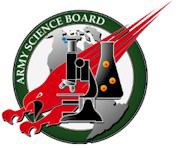Abbreviation ASB | Founded at Washington, DC | |
 | ||
Predecessor Army Scientific Advisory Panel Formation 16 November 1954 (1954-11-16) Purpose Advises senior leaders on scientific matters of concern to the U.S. Army. Headquarters United States Office of the Deputy Under Secretary of the Army (ODUSA) | ||
The Army Science Board (ASB) provides advice about army science to senior military leaders. The ASB is a Federal Advisory Committee organized under the Federal Advisory Committee Act. It is the Department of the Army senior scientific advisory body that was chartered in 1977 to replace the Army Scientific Advisory Panel. The ASB advises and makes recommendations to the Secretary of the Army, the Chief of Staff of the Army, the Assistant Secretary of the Army for Acquisition, Logistics and Technology (ASA(ALT)), the army staff, and major Army commanders on scientific and technological matters of concern to the Army. The Secretary of the Army delegates oversight authority to the United States Deputy Under Secretary of the Army, who functions as the ASB Director. Terms are generally three years.
History
The Army Science Board (ASB) has served as the Army’s senior scientific advisory board. When it was chartered as a Federal Advisory Committee under the Federal Advisory Committee Act in 1977, the ASB replaced the Army Scientific Advisory Panel (ASAP). Both the ASAP and the ASB grew out of the need for Army-specific guidance on scientific research and development (R&D) and the Army’s desire to maintain its strong technical advantage over other nations.
From the founding of the Army through the early 1900s, the Army did not have an effective R&D program — production and procurement were emphasized and the R&D during this era was limited to product improvement. Prior to World War II, the Army’s R&D was controlled through the G-4 as a function of the supply arms and services. In October 1943, Secretary of War Henry Stimson indicated that he wanted scientific help in the war effort, resulting in the R&D branch’s reorganization and its elevation to division level in May 1944. This elevation eliminated obstacles related to recruiting and retaining enough qualified scientific people, and provided them the clout to effectively perform their duties.
Following World War II, despite General Dwight D. Eisenhower’s warnings that using scientific and technological resources solely for procurement purposes limited the usefulness of those resources and indications that separating R&D from procurement and production would benefit the military, concerns remained that the senior Army leadership lacked the vision to effectively guide the direction of R&D programs. However, funding and personnel limitations continued to direct R&D toward the necessary areas of procurement and production. A few years later, Dr. Donald Loughridge, the Army’s Senior Scientific Advisor, was concerned that the Army lacked an effective basic research program, resulting in its inability to attract desirable entry-level scientists to its laboratories. By April 1950, Secretary of the Army Gordon Gray was also concerned with the Army’s R&D program and its ability to support warfighters in future wars. He did not believe that the United States could fight a war based solely upon soldiers, especially with the fall of China to communism.
Shortly thereafter, Gray’s replacement, Secretary of the Army Frank Pace, evaluated the existing Army R&D program, which was then engaged in supporting the Korean War. In January 1951, the evaluators recommended that a research advisory board be established to assist the Secretary of the Army in R&D matters. Based on this report, General Joseph Collins, Army Chief of Staff, recommended establishing an Army Scientific Advisory Committee as this research advisory board. By March, Pace approved establishing this board in principle and in November he took the first steps to obtain this scientific advice. Without formally establishing a committee, the Secretary appointed 10 outstanding scientists and industrialists as his scientific advisers. These pioneer advisers were:
Following the Korean War, the Advisory Committee on Army Organization analyzed the Army’s organization with respect to its ability to support the nation in times of war and peace. This committee praised the scientific advisory group’s creation, indicating it was a significant step in bringing the best scientific ability and experience to the Army. In 1954, the House Committee on Government Operations issued a report stating that the Army’s scientific advisory group was not being used effectively. Army Secretary Robert T. Stevens, Pace’s successor, concurred with these recommendations and established plans to formalize the ASAP with a permanent charter, enlarge its membership and give it more latitude in its efforts.
The ASAP — then with 25 members — held its first meeting November 16–17, 1954. During the meeting, the panel heard briefings on various areas involving the Army’s R&D efforts. By 1958, the panel grew to 70 members and divided itself into eight different subpanels:
Throughout its first 50 years, 590 people — including 50 women — have served as ASB members, resulting in more than 3,700 years of uncompensated, voluntary service to the Army. The ASB’s distinguished members also include two astronauts, three Olympians (one with a silver medal in the long jump), one U.S. Ambassador to France and a member of the first expedition team to ascend Mount Minya Konka in Eastern Tibet, China.
